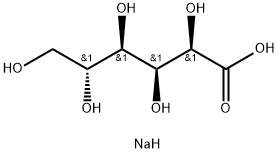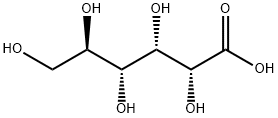D-Gluconic acid sodium salt , Medicinal grade , 527-07-1
Synonym(s):
Sodium gluconate;D -Gluconate sodium salt;D -Gluconic acid sodium salt;2,3,4,5,6-Pentahydroxycaproic acid sodium salt;Gluconic acid sodium salt
CAS NO.:527-07-1
Empirical Formula: C6H13NaO7
Molecular Weight: 220.15
MDL number: MFCD00064210
EINECS: 208-407-7
| Pack Size | Price | Stock | Quantity |
| 500G | RMB71.20 | In Stock |
|
| others | Enquire |
PRODUCT Properties
| Melting point: | 170-175 °C |
| alpha | [α]D20 +11~+13° (c=10, H2O) |
| storage temp. | Store below +30°C. |
| solubility | H2O: 0.1 g/mL, clear |
| form | Crystalline Powder |
| color | White to light beige |
| Odor | wh. to ylsh. cryst. powd., pleasant odor |
| PH | 7.0-8.0 (100g/l, H2O, 20℃) |
| biological source | microbial |
| Water Solubility | Very soluble in water; sparingly soluble in alcohol; insoluble in ether. |
| Merck | 14,4456 |
| BRN | 3919651 |
| Stability: | Stable. Incompatible with strong oxidizing agents. |
| InChI | InChI=1/C6H12O7.Na.H/c7-1-2(8)3(9)4(10)5(11)6(12)13;;/h2-5,7-11H,1H2,(H,12,13);;/t2-,3-,4+,5-;;/s3 |
| InChIKey | MPPJUDJABRMYJR-QZHCVFHNNA-N |
| SMILES | [C@@H](O)([C@@H](O)C(=O)O)[C@H](O)[C@H](O)CO.[NaH] |&1:0,2,7,9,r| |
| LogP | -3.175 (est) |
| CAS DataBase Reference | 527-07-1(CAS DataBase Reference) |
| EPA Substance Registry System | Sodium gluconate (527-07-1) |
Description and Uses
Sodium gluconate is the organic sodium salt of gluconic acid. Sodium gluconate is a chelator that forms stable complexes with various ions and ultimately prevents these ions from engaging in chemical reactions. Gluconates are naturally occurring substances that freely dissociate to the gluconate anion and its respective cations. Being fully biodegradable and non-toxic, it represents an environment friendly alternative to the common chelating agents used in cosmetics such as EDTA. In addition to this, sodium gluconate has a low acute toxicity to aquatic organisms.
Sodium gluconate is used as a natural preservative. It prevents the growth of microbes in our products to keep them safe for our consumers. It also works as a skin-conditioning agent and a chelating agent which helps cleansing products to foam better in hard water. You can often find sodium gluconate in soap, sunscreen, shampoo, toothpaste, hair products, makeup, and a variety of other personal care products.
Sodium gluconate has been used as a component of recording buffer used in two-electrode voltage-clamp (TEVC) recording in Xenopus laevis oocytes. It has also been used as a control for sodium.
Safety
| Symbol(GHS) |  GHS07 |
| Signal word | Warning |
| Hazard statements | H302-H315-H319-H335 |
| Precautionary statements | P261-P301+P312-P302+P352-P304+P340-P305+P351+P338 |
| Safety Statements | 24/25 |
| WGK Germany | 1 |
| RTECS | LZ5235000 |
| Autoignition Temperature | >200 °C |
| TSCA | Yes |
| HS Code | 29181600 |
| Toxicity | LD50 orally in Rabbit: > 2000 mg/kg |



